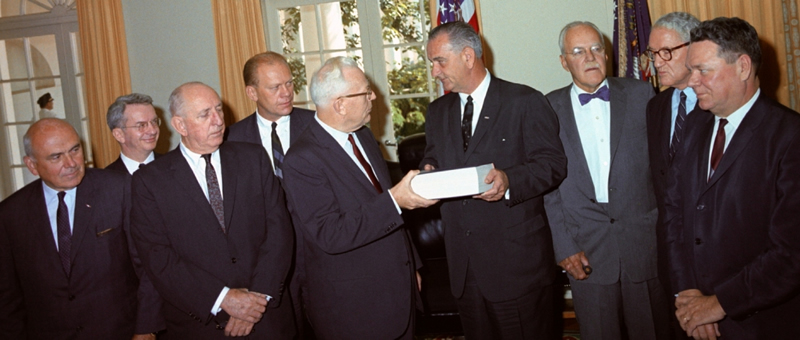 |
| Warren Commission Report |
The Warren Commission was established by President Lyndon Johnson on 29 November 1963, one week after the assassination of his predecessor, President John F. Kennedy.
The FBI was already working on assembling its findings into a report, which Johnson had hoped would serve as the last word on the subject, but his political advisors were urging him to appoint a presidential commission, and he decided that it would be a superior alternative to a looming U.S. Senate investigation of the assassination.
The commission included Supreme Court Chief Justice Earl Warren as chairman, four U.S. congressmen (Senators John Cooper and Richard Russell and Representatives Hale Boggs and Gerald Ford), and two members from the private sector (former Assistant Secretary of War John McCloy and ex-Director of Central Intelligence Allen Dulles). By the time its investigation was over, the commission and its staff of lawyers had interviewed 488 witnesses and received thousands of reports from dozens of government agencies.
  |
On 24 September 1964, the commission reported to President Johnson that Lee Harvey Oswald was the lone assassin of President Kennedy, that night-club owner Jack Ruby had acted alone in killing Oswald, and that the commission could find no evidence of a conspiracy in either murder.
The Warren Commission Report initially reassured an anxious public. However, its methods and findings were soon questioned by critics (e.g., Epstein), and by 1967 a majority of Americans had come to believe that a conspiracy was behind the assassination.
The hundreds of books that were written on the assassination over the years arrived at three different views of the commission. Its defenders (e.g., Ford and Stiles) portrayed it as an honest and competent body that explored every avenue in search of the truth.
Its legion of critics, on the other hand, saw it as either a bungled inquiry that ignored obvious evidence of conspiracy or, more ominously, as a deliberate cover-up intended to protect the conspirators.
These critics raised questions about the commission’s “single bullet theory,” which ascribed to one almost pristine bullet all seven nonfatal wounds sustained by Kennedy and Texas Governor John Connally, and they used the “Zapruder film” to argue for the existence of a “second gunman” in the assassination.
Despite the commission’s characterization of Oswald as a disaffected loner, the critics portrayed him as a man enmeshed in the covert world of espionage and/or an innocent patsy used to divert investigators from the conspirators behind the assassination.
It was eventually discovered that the commission was never informed about a note delivered by Oswald to the FBI before the assassination or about plots pursued by the CIA against the life of Fidel Castro, facts that could have had a significant bearing on the commission’s investigation.
Members of the commission staff assured the House Select Committee on Assassinations (HSCA) in the late 1970s that they carried out an honest and thorough probe of the assassination. Although the HSCA found no evidence of a deliberate cover-up, its conclusion was that the Kennedy assassination was probably the result of a conspiracy that had gone undetected by the commission.
Constraints on the Commission
In hindsight, it can be seen that the commission operated under several constraints that made it unlikely that it would find a conspiracy. With a limited investigative staff of its own, its inquiry relied largely on the FBI, an agency that had already satisfied itself that there was no conspiracy and behaved as if its reputation rested on the truth of that conclusion.
High government officials sided with the FBI and were determined to see that the public accept Oswald’s guilt and that suspicions of conspiracy, whether foreign or domestic, be rebutted by the commission.
Johnson’s own fears were clearly revealed when, while urging Warren to head the commission, he warned that rumors of conspiracy could provoke a nuclear war with the Soviet Union in which 40 million Americans would perish.
Johnson’s aides also wanted to remove the assassination as a possible factor in the 1964 presidential election by having the commission complete its report before election day in November, a deadline that the commission managed to meet by halting its hearings in June and assigning the task of writing the report to two staff members who worked nonstop until September.
When three commissioners (notably Senator Russell) took exception to the single-bullet theory, the disagreement went unresolved but the report was written as if there were consensus on all of its findings.
Indeed, the report referred to all allegations of conspiracy as “rumors,” implying that they were not worthy of being taken seriously.
The question of whether or not the commission failed to discover a conspiracy rests on whether a conspiracy actually existed. Regardless of the persuasiveness of their criticisms, or their success in making the idea of conspiracy appealing to many Americans, the commission’s critics never proved beyond a doubt the existence of any particular conspiracy.
The commission’s shortcomings may have been understandable in view of the constraints placed upon it, but the commission was not as objective in its fact finding as it pretended to be, or as fully informed.
Like many of its critics, it too produced a theory about the assassination, but it presented its theory as if it were fact, in a sense inviting the plethora of conspiracy theories that have competed with its lone gunman theory. The heritage left by the Warren Commission Report was a lingering belief in conspiracy on the part of most Americans, the very outcome that the commission was supposed to avoid.